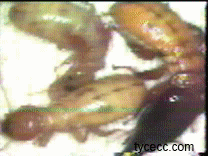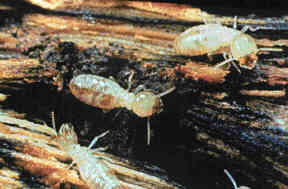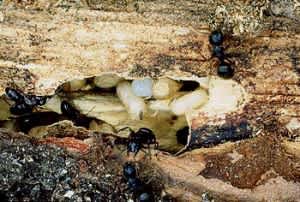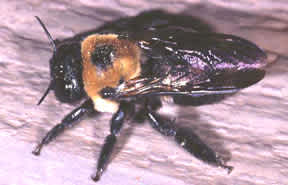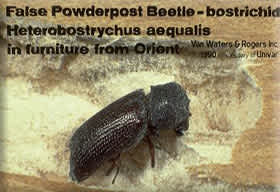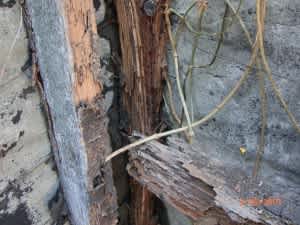Drywood termites are most prevalent in southern California, but also occur along most coastal regions and in the Central Valley. Drywood termites have a low moisture requirement and can tolerate dry conditions for prolonged periods. They remain entirely above ground and do not connect their nests to the soil. Piles of their fecal pellets/droppings, which are distinctive in appearance, may be a clue to their presence. The fecal pellets are elongate (about 3/100 inch long) with rounded ends and have six flattened or roundly depressed surfaces separated by six longitudinal ridges. They vary considerably in color, but appear granular and salt and pepperlike in color and appearance. Winged adults of western drywood termites (Incisitermes minor) are dark brown with smoky black wings and have areddish brown head and thorax; wing veins are black. These insects are noticeably larger than subterranean termites.
The western subterraneantermite, is the most destructive termite (section “1″ category pest / Structural Pest Control) found in California, becase of the damage they cause to foundation and structural support wood. They are often found in wood that has wood rot. The reproductive winged forms of subterranean termites are dark brown to brownish black with brownish gray wings.
Subterranean termites are smaller than drywood termites, being approximately one-fourth inch long. They create colonies in the soil and require moisture to survive. Unlike drywood termites, they do require a direct connection to soil. They build tubes up the side of concrete foundations or straight out of the ground, making highway tunnels for traveling to their food source and back
Another destructive species in this group is the Formosan subterranean termite, Coptotermes formosanus. They are now in California but restricted to a small area near San Diego and Los Angeles. Unlike the western subterranean termite, the Formosan subterranean termites swarm at dusk and are attracted to lights.
The black carpenter ant is a common invader of homes at the California. They are about 3/4 of an inch in length. Carpenter ants normally nest in logs, stumps, and hollow trees. Though they do not eat wood, but they bore into wood framing and wood cabinets to make their nests, which causes structural damage. They are usually noticed by home owners during swarming season. These ants seldom tunnel into dry, sound wood, but they may excavate moist, rotting woods to make their nests.
Carpenter Bees are large black bees that bore holes into wood to make their nest to lay eggs. They are usually found in fences and trees. The holes are about 1/2 of an inch in diameter and about 2 inches deep.
Powder Post Beetles are found in a variety of wood products. They infest everything from wicker baskets to hardwood floors and pianos. They are usually detected by seeing very fine saw dust or little holes in wood surfaces. The holes are the openings for when adult beetles emerge. Powderpost beetles prefer the sapwood of oak and other hardwoods. They breed in an infested piece of wood for generations, which result in the ultimate destruction of the wood.
Dry rot (section “1″ category: Structural Wood Destroying Organism) is due to severe timber decay in buildings. Described as a brown rot, it often occurs in damp timber due to un-vented spaces and when in contact with, or embedded in, wet brickwork or masonry. The fungus is sensitive to high temperatures, air movement, and rapid drying. Exposed timbers and timbers due to good ventilation are rarely affected. Affected timbers take on a very dull brown color. The dry rot fruit body is often found on a timber to wall joint as a reaction due to unfavorable conditions. The body is quite tough and fleshy to feel and develops a pancake like shape. The center is a yellow ocher when it is young and develops to a deep rust color when it is older. The deepening in color is a result of the fine, brown spores it produces which are generally gathered in a dust below the body. The edges of the fruit body will be white or grey. The fruit body may be the first visible sign of dry rot out break.
